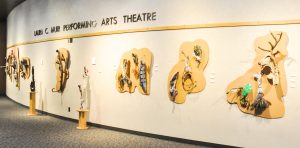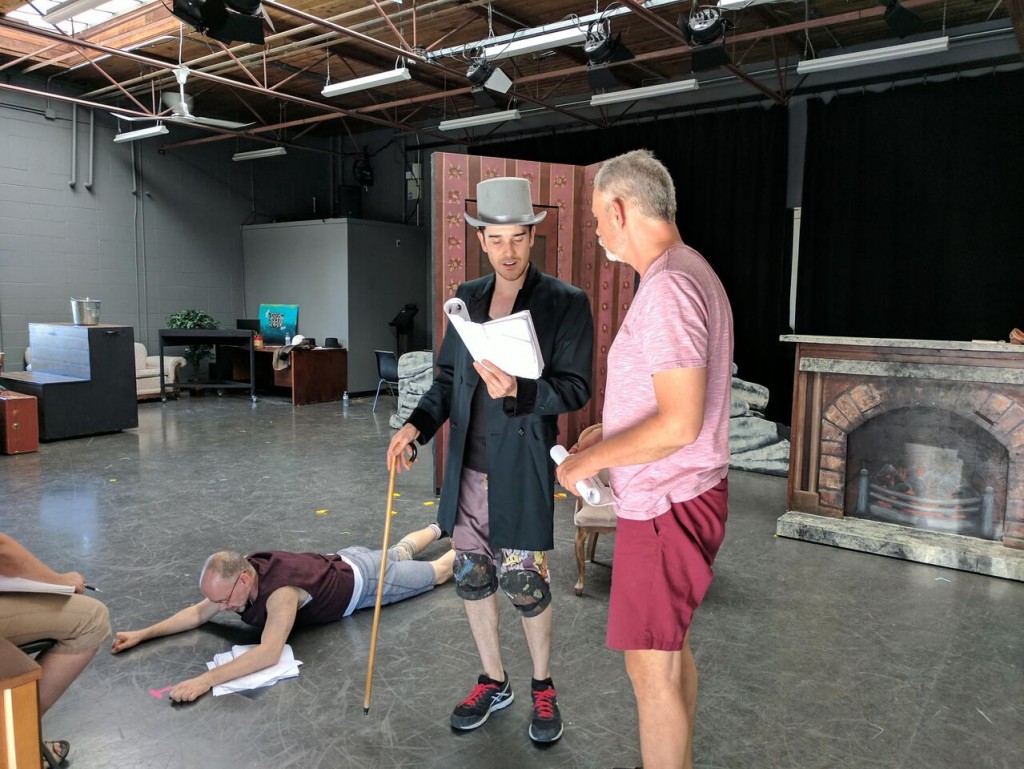
Art gallery reopens with innovative sculptures and installations
By Caroline Ho, Arts Editor
The Amelia Douglas Gallery’s newest show brings together two ocean-themed exhibits that speak to the power of repurposed materials.
“Landlocked?” and “Flotsam Fixation” feature installations and sculptures created by Tiki Mulvihill, an artist currently based in Vancouver. The exhibits, which are part of the annual New West Cultural Crawl art festival, opened in the Gallery on August 2, with a reception on August 11 where visitors also had the opportunity to participate in a collage workshop guided by the artist.
“Landlocked” is comprised of a 6’5” crafted wooden boat hanging from a large wooden frame, in addition to six 30” by 40” drawings. The exhibit tells the narrative of a man who starts building a boat in his shed. As he progresses through life, through ups and downs in his family and career, he continues crafting his vessel, devoting more and more obsessive attention to it—but he never finishes the construction.
Mulvihill’s model is made of parts from an actual full-size boat, the artist said to the Other Press at the opening reception. The components on the inside of the vessel consist of various objects and items she’s collected and are purposely meant to look incomplete, keeping with the narrative. She based the exhibit’s drawings partly on photos found in her family’s collections.
Mulvihill doesn’t have one specific source of inspiration for the story behind “Landlocked?”; rather, the idea developed throughout the process of building the boat.
“I just started, and then I came up with an idea,” Mulvihill said. “That’s the way I was with installations […] I’d come up with a notion or an idea, and I would create things.”
While many of the works she’s done previously have been installations, “Flotsam Fixation” is instead a series of sculptures made from driftwood and repurposed materials, hanging on the walls outside the Gallery in groups of two or three on smooth wooden mounts. Some of the pieces appear organic and animal-like, such as Cervidae, shaped to resemble a deer head; others like Transact Belt-Built are more inorganic and abstract, yet all are full of whimsical, individual character.
The driftwood is collected from the shores of Vancouver Island, while the repurposed materials are household objects, tools, and other various bits and pieces accumulated and bought second-hand over the years. Some of the sculptures are assembled out of similar materials such as metals or items with related purposes, while many more have been pieced together on the driftwood based on colour, form, and what seemed to fit.
“A lot of them, it’s the colour, but those things were not connected or close to each other,” she said of the sculptures’ repurposed components. “It would evolve over time. It was fun because I would just sort of make things.”
The combination of driftwood and found objects, according to Mulvihill’s exhibit text, is meant to “evoke inquisitiveness about the objects’ users and usage, and to fuse the past and the present within the cross-cultural lens of Canada.”
Mulvihill said the next project she’s currently working on is an installation called “East Past to West Present,” which will walk viewers through the history of Canada in a series of sculptures representing the provinces, moving through each province both geographically—from east to west—and chronologically.
“Landlocked?” and “Flotsam Fixation” will be on display in the Amelia Douglas Gallery until September 8, with a closing reception and artist’s talk held in the Gallery on September 7.

